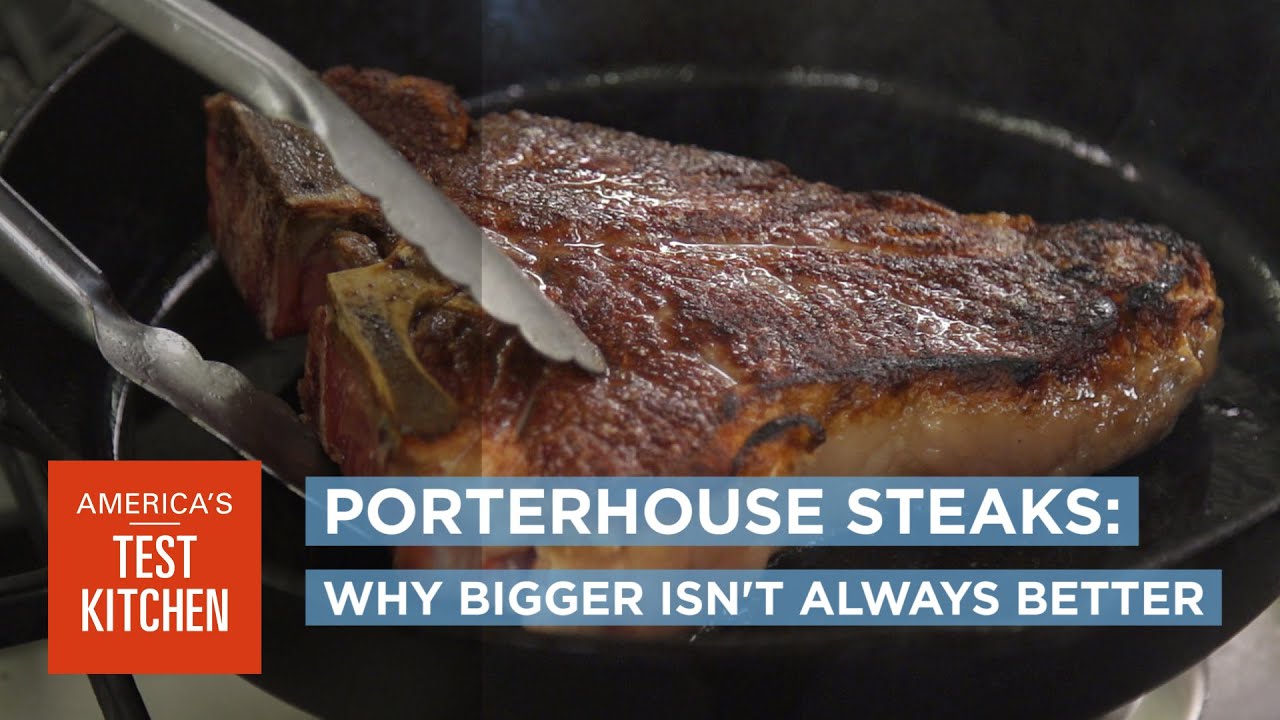Cook’s Science, buy now!
The Science of Good Cooking:
Subscribe to our new Cook’s Science YouTube channel!
When buying a porterhouse, steak buyer beware. The porterhouse steak with the largest tenderloin section is, surprisingly, not the best.
A regular porterhouse has a smaller tenderloin, but there’s no top sirloin attached to the shell muscle. A vein-end porterhouse has a larger tenderloin, but contains a chewy section of top sirloin.
Watch more Science!
Why You Literally Can’t Overcook Mushrooms
How to Make Cheap Cuts of Steak Tender
In the beef world, it doesn’t get much more impressive (or expensive) than a porterhouse steak, a cross-cut, bone-in slice of the short loin. This cut features a large section of buttery tenderloin (by definition it must be at least 1 1/4 inches in diameter—anything smaller is labeled a T-bone) on one side of the bone and a section of the beefy shell muscle on the other.
When shopping for a porterhouse, many cooks make the mistake of looking for the steak with largest tenderloin portion possible. Why is that a problem? Well, it turns out that where the tenderloin is largest (roughly the last 6 inches of the short loin before it meets up with the sirloin), the accompanying shell portion is divided by a line of tough sinew. On the outside of that line sits a portion of top sirloin, a much more heavily used muscle. Steaks cut from this section are colloquially known as vein-end porterhouses, and while they may look impressive at the supermarket, they are supposedly tougher on the plate.
To see and taste the difference ourselves we visited Kinnealey Quality Meats in Brockton, Massachusetts, where butchers cut us vein-end and center-cut (where there is no section of top sirloin) porterhouses from three different short loins. Back in the kitchen we vacuum-sealed the steaks, cooked them in a water bath to an internal temperature of 125 degrees, and tasted.
Sure enough, once tasters crossed the vein of sinew, they were met with a significantly chewier piece of meat. The section of top sirloin was not only tougher, but it was also streaked with chewy connective tissue and rubbery fat. So if you don’t wish to pay porterhouse prices for sirloin quality, look for a porterhouse where the shell muscle isn’t marked by a vein of sinew.
If you like us, follow us:
Related posts
16 Comments
Leave a Reply Cancel reply
You must be logged in to post a comment.


All that extra money in VEIN. 🙂 In all seriousness, thanks for the tip!
Sounds like a lazy eater to me, sometimes a little work is required to get the best out of anything. Your soy is showing
Just buy T-Bones
Just cut the vein of sinew out. I would argue the filet cut is much more expensive than the strip. So a bigger filet mignon is better!
I will take a ribeye any day over porterhouse, t bone, filet mignon or strip steak. Even though the last 2 are broken down pieces that make a t bone and porterhouse.
Most people would be surprised to know that that specific additional muscle has a completely different taste and is loved in several places. It is called Bistecca alla Fiorentina, if you prepare it properly.
Great vid, very thorough and informative!
Never knew that, love all the science behind cooking series, I really learnt a lot, thank you for sharing!
I could eat a porterhouse everyday for breakfast, lunch and dinner!!!!!!!!
Very helpful, thanks.
Good informative video, thanks
Thanks for the info…. Lots of supermarkets sell porterhouse steaks that really should be labeled t-bones, but worst of all they charge the same price…. What a fraud!!!
How about you get a smaller piece of meat so (you know) you don't get cancer. Oh wait, Americans…
Don't tell everyone, geesh.
Hehe
Good video
Great info. Not something the average shopper would even consider.
awesome tidbit of info